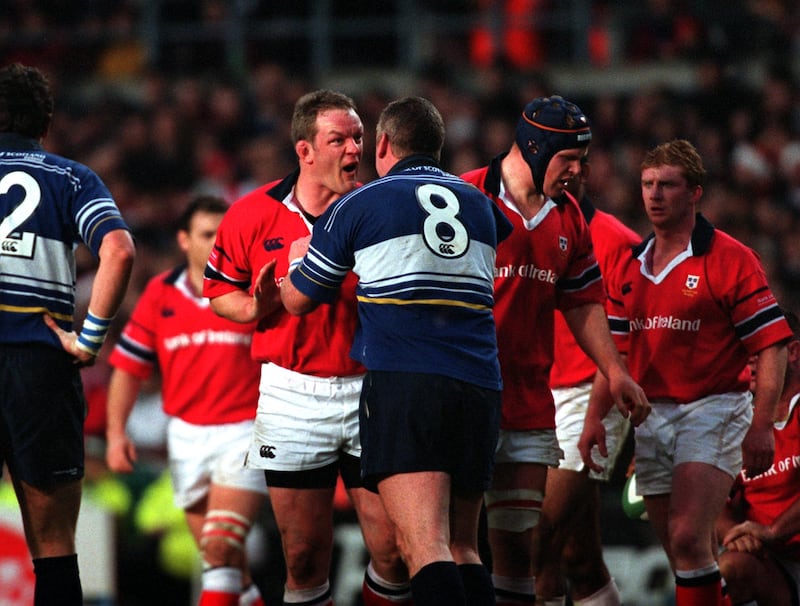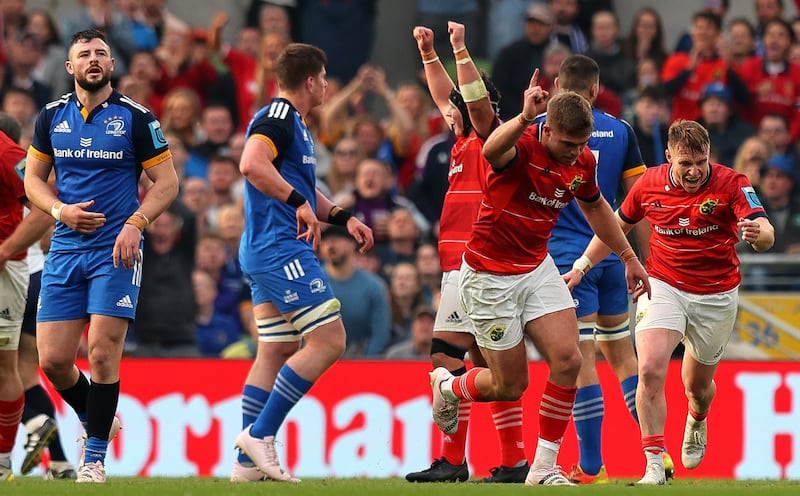This surely seals it, a record attendance at a BKT URC match in Croke Park fully 15 seasons on from a record attendance at a Champions Cup game. Leinster and Munster may be the fiercest of rivals, but as a result they can jointly take a bow, for they can legitimately claim to have the biggest rivalry in world club rugby.
Saturday evening’s near 81,000 attendance underlines the point, smashing the previous URC record of 68,262 that attended the ‘Judgement Day’ Welsh double header at Cardiff’s Principality Stadium back in 2016.
Sure, the world record attendance for a club game remains the 83,761 crowd at the competitively priced Premiership game between Saracens and Harlequins at Wembley in May of this year, but those examples were one-offs.
Leinster-Munster attendances have consistently dwarfed all others over the last two decades. The Blues-Crusaders Super Rugby final of two years ago drew 45,000 to Eden Park, but since then the biggest attendances at derbies in New Zealand, where rugby is the country’s number one sport, have been in the low 20s.
Last season’s two Glasgow-Edinburgh derbies attracted 7,172 at Scotstoun and 37,381 at Murrayfield and 20,167 were at the Judgement Day double-header. French club rugby is booming but is more diverse and spread out, and there is no head-to-head which could consistently compare to Leinster-Munster.
Perhaps the closest are the South African derbies between the Bulls and Stormers. Two seasons ago, the attendances at Loftus Versfeld and the DHL Stadium were 41,000 and 30,000, while last season they were just over 50,000 and 39,925.
But the Leinster-Munster rivalry has morphed into a phenomenon. The 40 meetings since the 2005-06 Champions Cup semi-final at the old Lansdowne Road, excluding the five matches behind closed doors during lockdowns, have attracted over 1.25 million at an average of 31,380. After Saturday evening’s encounter, that average will increase to 32,500-plus since 2006.
Off the pitch, the two provinces have facilitated each other’s wishes, and Leinster have swelled their budget by regularly moving their home clash with Munster, and one European pool game, to the Aviva. Had they drawn La Rochelle at home in the pool stages this season, they’d have moved that tie to Croke Park as well, but their annual home meeting with Munster remains a standout marquee fixture.
Deducting the cost of hiring the stadium at roughly €300,000 from the IRFU, the 45,000-plus attendances have equated to circa €1.3 million in gate receipts for Leinster. Given similar costs in hiring Croke Park from the GAA, it’s likely that this game will generate an additional €500,000 to €600,000 (circa €1.8/1.9 million).
As Munster supporters will no doubt wryly observe on the night RG Snyman makes his home debut in blue, the additional income is enough to cover the dual World Cup winner’s annual salary.

But it wasn’t always like this.
While there was an intense Leinster-Munster rivalry among the players and at club level, with five-figure crowds a regular occurrence in the 90s, it took a while for this to be transferred to supporters of the two provinces.
Back on August 21st, 1998, when Thomond Park was being upgraded for the 1999 World Cup, Munster hosted Leinster at Garryowen’s ground in Dooradoyle. Accounts vary as to the attendance but if anyone tells you they were there, take it with a good dollop of salt.
[ RG Snyman to make home Leinster debut against former side Munster at Croke ParkOpens in new window ]
David Wallace, who was a replacement for Munster, and Liam Toland, who was at the game, reckon there were 200 in Dooradoyle on that sunny Saturday afternoon.
Leinster won 24-18, thanks to tries by Girvan Dempsey and Shane Horgan – neither of whom had yet been capped by Ireland – and 14 points from Alan McGowan. After three successive defeats to Munster and an opening day loss to Ulster, Leinster’s need was greater.
“Nothing concentrates the mind like impending doom,” said the then Leinster manager Jim Glennon afterwards.

Leinster vs Munster- the history of a bitter rivalry
The following season Munster completed a double over Leinster en route to retaining the interprovincial title with 31-20 and 30-13 wins at Temple Hill and Donnybrook.
The rivalry has long since outgrown Dooradoyle, Temple Hill and Donnybrook but given how much money this game has consistently generated, especially for the coffers of Leinster, Munster and the IRFU, it’s a wonder it took so long for the penny to drop, as it were.
The first inkling that this auld rivalry, the first of 170 meetings dates back to 1877, might have something special about it came with the inaugural Celtic League final at the old Lansdowne Road in December 2001 when 35,000 attended.
Leinster had won one of the previous eight, but despite Eric Miller’s 26th-minute red card and Munster leading 15-6 early in the second half thanks to tries by Anthony Foley and John Kelly, Leinster responded with tries by Gordon D’Arcy and Shane Horgan to win 24-20.

Even then, though, the IRFU didn’t twig they had an untapped golden goose in their back yard, nor did the provinces or the league organisers. Far from Leinster-Munster clashes, let alone double-headers, being enshrined in the seasonal fixture list, they didn’t meet at all in 2002-03. You couldn’t make it up.
Just as irritatingly, Irish frontliners were regularly kept back from Leinster-Munster clashes for fear that they might be injured. Thereafter, though, they met twice per season in Donnybrook and Musgrave Park in front of 5,400 to 8,000 attendances before a 2005 Celtic League semi-final drew 13,500 to the old Lansdowne Road.
Temperatures rose in the 2005-06 season after Leinster avenged a 33-9 hammering in Cork by beating Munster 35-23 in a cracking New Year’s Eve clash, their first at the RDS, in front of 14,135.
By now the Ronan O’Gara-Felipe Contepomi rivalry was in full swing but all changed utterly when two tribes went to war in the Heineken Cup semi-final at the old Lansdowne Road in the ensuing April. Leinster went into the game as slight favourites after an epic 41-35 quarter-final win in Toulouse three weeks previously, whereas Munster had laboured to a 19-10 victory over Perpignan.
Technically Leinster had home advantage but come that sunny Sunday in April, the Munster invasion turned the ground into a sea of red. After so many near misses, Munster and their vintage pack, the Peter Stringer-O’Gara axis and their supporters, simply couldn’t countenance the thought of Leinster reaching their Holy Grail before they did.

Munster won 30-6 with tries by Denis Leamy, O’Gara and Trevor Halstead en route to sealing their first Heineken Cup by beating Biarritz on an emotional day in Cardiff in three weeks later.
Though they might be loath to admit it, the best thing that ever happened Leinster was Munster. That semi-final was a day of awakening.
“It galvanised me, and our coaching staff,” the former Leinster CEO Mick Dawson said subsequently. “They said we weren’t good enough on the pitch and we said we weren’t good enough off the pitch.”
There was another wake-up call the following October when the provinces met for the next time in the fifth round of the Magners League on a Friday night in Lansdowne Road.
“We’d sold 12,000 tickets for the match,” recalled Dawson. “We had a meeting on the Monday with all the stewards, and we asked ‘how many walk-ups do you think we’ll get?’ We were told that we wouldn’t get more than 5 or 6,000 people walking up. About 35,000 people turned up. We had to let almost 10,000 in for nothing.”
“It was mayhem, and suddenly we had to look at our whole operation as to how we were going to handle these big matches – ticket sales, security, health and safety – because we had never experienced anything like this before.”

Leinster’s day of reckoning came when the sides met again in the 2009 Heineken Cup semi-finals in front of a then world record crowd of 82,208 at Croke Park. The 50-50 breakdown resembled a blue and red checkerboard.
Munster, twice champions in the previous three seasons, were hot favourites but for Brian O’Driscoll and the home-grown galacticos, reinforced by Ricky Elson, Isa Nacewa, CJ van der Linde and Chris Whitaker, there was no turning back, least of all when Johnny Sexton replaced Contepomi.
Nothing concentrates the mind like impending doom all right.
Leinster’s 25-6 win led to their breakthrough Heineken Cup triumph three weeks later against Leicester in Murrayfield – the first of three in four years, and first of four stars overall. Although Munster denied Leinster a double in the Magners League final of 2011, they haven’t been back to a European final since.
More than any other interpro derby in history, it marked a defining shift in the balance of power.
Munster had won 12, drawn two and lost five of the previous 19 clashes, and from 1990-91 to 2009-10, Limerick and Cork clubs won 17 of the first 20 AIL titles.

Starting with that day, Leinster have won 29 of the last 38 meetings, while their clubs have won nine of the last dozen AIL titles. Where Munster were bulk suppliers up to and including the 2009 Grand Slam, Leinster have since filled that role.
In many ways, the best thing that happened the rivalry in recent times was Munster’s 16-15 URC semi-final win at the Aviva two seasons ago courtesy of that late Jack Crowley drop goal en route to ending their 11-season trophy drought.
A rivalry doesn’t stand up very well to the description if the same team keeps winning. It has surely inspired their fan base to travel on Saturday and anecdotal evidence suggests that the novelty value of Munster’s first venture to Croke Park since that day in May 2009 has swelled ticket sales.
The return of so many Irish frontliners last week – and the unveiling of Snyman – for their first game since the epic second Test win in Durban also saw a spike in ticket sales.
Fresh plot lines help, as does six weeks to sell the game. And to think that a huge audience will also be watching on RTÉ. A quarter of a century on from Dooradoyle, it’s come a long way all right.
Leinster v Munster in numbers
170 – The amount of times the two sides have met since the first clash in 1877, with Leinster winning 109, Munster winning 50 and 11 draws.
1,355,200 – The total number of spectators at the last 40 matches since the 2006 Heineken Cup semi-finals, excluding the five games behind closed doors during lockdowns.
31,380 – The average attendance at those 40 games.





















